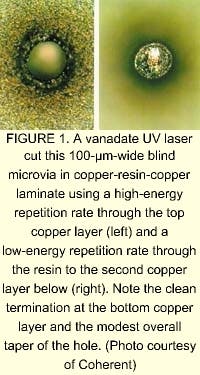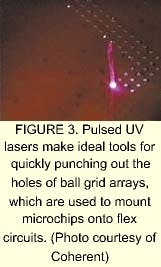UV solid-state lasers exhibit precision and dependability
Ronald D. Schaeffer and Terry Hannon
Modern industry requires cutting and drilling tools that combine power with precision and dependability with adaptability. Lasers have become a tool of choice for precision machining, able to cut or drill through materials ranging from stainless steel and molybdenum to Mylar films and fabrics. Laser beams do not become dull or break. Moreover, the service life of industrial lasers now extends to many thousands of hours. Recently, ultraviolet (UV) lasersespecially excimers and the latest diode-pumped frequency-tripled Q-switched vanadate lasershave taken laser micromachining to a new level of precision and reliability for a variety of micromachining applications.
Ultraviolet lasers offer particular advantages over other lasers as micromachining tools. Drilling or cutting with a CO2 laser, for example, is essentially a thermal process in which the intense beam literally melts and vaporizes the material. While the quality and speed of the cut are much superior to conventional methods, the result may induce thermal degradation of the material surrounding the cut (known as the Heat Affected Zone or HAZ). This can reduce precision and, in the case of microelectronics, can create failure-inducing conductive paths. In contrast, UV laser light interacts with materials primarily through photoablation, in which the high-energy photons actually break molecular bonds. The result is a clean cut with minimal disruptive effect on the surrounding material.
The shorter wavelength of UV lasers also allows higher resolution through a closer concentration of focused energy. When drilling microvias, for instance, the practical limit for the minimum hole size for a CO2 laser is 75 mm, whereas a solid-state UV laser emitting at 355 nm can produce microvias of 25 mm or less in diameter.
Another advantage of UV laser machining is the greater absorption of many materials at UV wavelengths. Copper, for example, is highly reflective at IR wavelengths, rendering CO2 laser cutting ineffective unless the copper is pretreated.
The high reliability of a solid-state UV laser combined with its short wavelength and pulse duration has opened up a widening array of industrial applications. For example, at PhotoMachining Inc. (a specialized laser-processing job shop), about 50% of orders relate to microelectronics, which is typical of the overall market. An additional 30% are medical applications that primarily involve drilling microvias or otherwise fabricating plastic medical equipment or components. The remaining 20% of orders range from ink-jet printers to aerospace applications, thin-film patterning, and cutting chemical-vapor-deposited (CVD) diamond-coated materials.
Techniques and applications
Typical microelectronics applications range from solder-mask removal to drilling microvias in circuit boards. Solder-mask removal can be used to repair mistakes made during original fabrication; it can also be engineered as part of the fabrication process, in which solder mask is freely applied and the UV laser then removes the excess. The most common treatment entails the removal of solder mask from exposed surface pads that have a distinct size and shape. The simplest arrangement occurs when the pads are all the same size and their locations are defined in DXF or Excellon2 files (computer-numerical-controlled drill formats). To avoid misalignments caused by board-to-board irregularities, fiducial alignment points ensure accurate and consistent positioning of each board. More challenging situations involve randomly distributed pads or entire conductive surfaces that must be cleaned.
Working with circuit boards involves procedures that may be applied to a broad assortment of laminates. A typical circuit board consists of a sandwich-like construction with a layer of dielectric between two layers of copper. To make microvias in the board, the UV laser first drills through the front layer of copper using a high-energy delivery rate. Next, the energy delivery is reduced as the laser cuts into the dielectric by increasing the repetition rate. This produces a clean hole without cutting through the back layer of copper (see Fig. 1). Average laser power (determined by the pulse rate) can be pre-programmed and automatically adjusted by the control software.
This type of job may be set up in either of two ways. One is to change laser power settings as each microvia is drilled. The other is to first cut through the copper layer for all the required microvias, then remove the dielectric and perform final cleanup, adjusting power once for each stage. Since CO2 lasers cut through dielectric more quickly, an alternative method is to use a Q-switched UV laser to cut through the copper, then a CO2 laser to remove the dielectric.
Similar power-variation procedures can be used to work with diverse laminates for various applications. With proper setting of power levels it is possible to cut or drill laminates made of very different materials. When working with coatings on UV-transmissive materials such as quartz or some types of glass, the laser beam can be passed though the transmissive material, cleanly ablating the coating off the other side with no effect on the parent body. Materials such as Mylar, used extensively in medical devices, have poor UV absorption at 355 nm. If laser energy levels are not properly controlled, excess energy leakage may result in melt and distortion of material surrounding the cut. However, consistently good results can be achieved with Mylar by carefully controlling energy settings and pulse rate. Kapton, which has high UV absorption, is well suited to UV laser cutting and drilling, as are Lexan, polycarbonates, stainless steel, molybdenum, and various thin films such as indium tin oxide (see Fig. 2).
A tale of two lasers
Two types of UV lasers are now in general industrial use. Gas excimer lasers became available for industrial applications in the early 1990s. But the scope of UV-laser micromachining applications has now been greatly broadened by the introduction of frequency-tripled solid-state Q-switched vanadate lasers, such as those made by Coherent, which offer several processing and operational advantages in industrial applications.
Excimer lasers remain unmatched in pulse energy, but their poorer beam quality and slower pulse rate make them better suited for micromachining with photomasks or reticles. An ideal excimer laser application is drilling microvias using a photomask, in which the microvias are very small and closely packed within a small area. Excimers also excel at drilling the tiny holes in ink-jet nozzles. Moreover, some materials absorb better at the shorter UV wavelengths accessible to excimer lasers. Excimers, however, are large, bulky, relatively expensive lasers that consume lots of coolant water and electricity, use toxic gases, and require a more highly trained operator.
Frequency-tripled solid-state Nd:YAG lasers, on the other hand, produce a more coherent, collimated UV beam. These lasers are therefore more suitable for cutting complex shapes such as flexible circuits or for drilling microvias over a relatively large surface area (see Fig. 3). Vanadate lasers also can provide a much broader range of pulse rates. Rather than the 200-Hz pulse rate typical of excimer lasers, the Coherent laser used at PhotoMachining Inc. provides a pulse rate from single-shot to 100 kHz without compromising beam quality.
Today's diode-pumped solid-state UV lasers are compact, air-cooled, run from a standard wall socket, and designed for hands-free operation. For example, a solid-state UV laser system has been set up for a 30-hour job on a Friday and left operating for the weekend, with the job finished on Monday and the processed parts ready to package and ship. In any particular job the last part processed by the laser is identical to the first. Production rates for certain jobs also have increased from five to 50 times using a solid-state UV laser instead of an excimer.
Two means are available for delivering the solid-state UV laser beam to the workpiece: a fixed-beam system in which the part moves on an x-y table, and a flexible-beam system in which the beam moves over the part using a high-speed galvanometer. Each method has its own advantages, depending on the job requirement. A galvanometer-aimed beam provides higher operating speed than does an x-y table. On the other hand, the available resolution level is lower with the galvanometer than with a fixed-beam system. The fixed-beam system also allows coaxial flow of assist gas, providing greater cleanliness of the cut and in some cases higher processing speed.
Industrial solid-state Q-switched UV lasers have demonstrated a long operational lifetime with consistent service performance. The two consumables in these lasers are the diode-laser packs and the nonlinear crystal used to produce the frequency-tripled beam. Diode lifetime for the Coherent laser used by PhotoMachining has so far reached more than 13,000 hours and counting. In this unit, the crystal can be shifted automatically, allowing more than 20 spot locations on the crystal to be used, each spot having a lifetime of at least 1000 to 2000 hours with only a 5% to 10% degradation of output power. Optics are soldered in place in the laser, without spring-loaded mounts that relax and creep under the influence of vibration and temperature changes, causing misalignment.
Ultraviolet lasersboth excimer and frequency tripled solid-statehave established a new standard of precision in the micromachining workplace. Solid-state lasers now offer the additional advantages of reliability, simplicity, and flexibility of operation in micromachining tasks, from producing microvias in film or laminar materials to precision cutting and trimming. For applications ranging from microelectronics to medical equipment production, solid-state UV lasers offer high versatility with low operational costs for the micromachining industry.
RONALD D. SCHAEFFER is chief executive officer of PhotoMachining Inc., 4 Industrial Drive, Pelham, NH 03076; e-mail: [email protected]. TERRY HANNON is product line manager at Coherent Inc. Laser Group, 5100 Patrick Henry Drive, Santa Clara, CA 95054; e-mail: [email protected].


